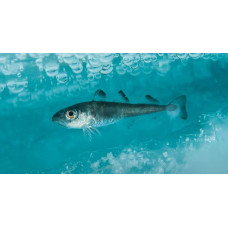Boreogadus saida is a marine fish of the cod family. The eyes are large. There is a very short antenna on the chin. The lateral line is interrupted, zigzag. Small fish, 25-32 cm long, usually 12-16 cm. It inhabits the seas of the Arctic Ocean. Leads a pelagic lifestyle. Sexually mature in the 3-4th year of life. Spawning is portioned, from October to March. Fecundity up to 20 thousand eggs. Planktophage. Serves as the main food of marine mammals. Local commercial importance.
Maximum body length 40 cm, usually 25 cm, maximum life span 7 years. Body strongly thinning towards the tail. The caudal fin has a deep notch. The head is large, the lower jaw is slightly forward, the antenna on the chin is small. The eyes are large, with a diameter greater than the height of the caudal stem. Top of head and back grayish-brown; sides and belly silver-gray.
The saika is distributed circumpolarly throughout the Arctic Ocean, occurring both near and far from shores, usually under floating ice and in rifts. It enters to the north of any other species, up to 85°N. It is found in brackish lagoons and river mouths.
It lives in surface sea waters, freshened by thawing ice, at near 0 °C or sub-zero temperatures. It rarely descends to depths below 700-900 meters. It tolerates low temperatures due to the presence of a natural antifreeze in its blood - AFGP glycoprotein, which prevents freezing.
In the fall, saika gather in large flocks, often approaching the shores, forming mass aggregations in coastal waters and river mouths. Spawning takes place from October to March; eggs are floating, pelagic. Fecundity is 6-70 thousand eggs.
The saika becomes sexually mature at the age of 3-4 years, reaching a length of 19-20 cm.
The saika feeds on phyto- and zooplankton, crustaceans, mainly euphausiids, juvenile fish.
Boreogadus saida
Tags: boreogadus saida


